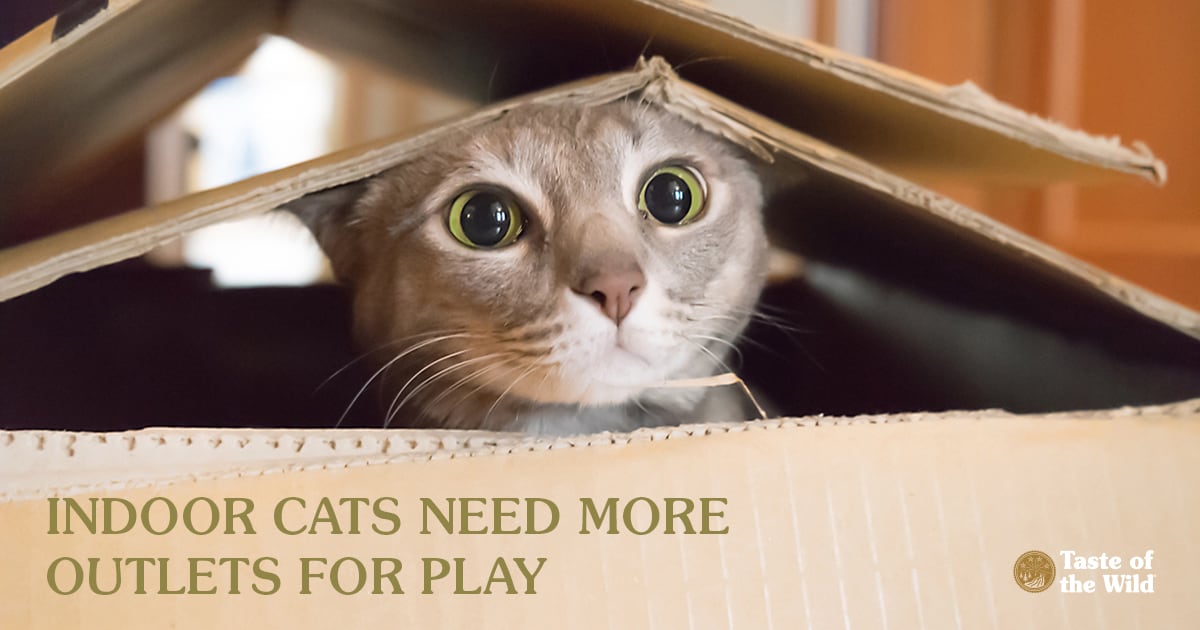
Cats have a reputation for being independent, low-maintenance pets — so much so that it’s often said everyone needs “a dog to adore you and a cat to ignore you.” But as it turns out, they’re not as self-sufficient as you may think, especially when it comes to living indoors.
QUIET LIVES OF DESPERATION
You might assume that indoor cats have a cushy life: no cars or vicious dogs to deal with, and food is served up without a protracted hunt. However, they often fall victim to something less obvious — stress from boredom and lack of stimulation.
This underlying stress can lead to urinary tract disease, obesity, increased vulnerability to infections and gastrointestinal issues. It might also manifest in behavior problems such as accidents outside the litter box, aggression and overgrooming.
It’s important to visit your veterinarian to rule out any medical issues that could contribute to the problem. Once your cat gets a clean bill of health, you can look into ways to enrich the environment to meet your cat’s physical, emotional and social needs.
To help, the American Association of Feline Practitioners and the International Society of Feline Medicine created Environmental Needs Guidelines for cats, which focus on five basic principles.
Cats Need a Safe Retreat
It’s important to create a safe area where your cat can get away from children and other pets, or snooze in privacy.
Try leaving an open cardboard box or paper shopping bag (with the handles cut off) on the floor, and chances are, your cat will hide inside it. A cat carrier lined with a soft blanket, toys and treats can also be a great place to hide.
Many cats prefer to perch in high places, such as cat trees and shelving, where they can feel less vulnerable to potential predators. Perches can be placed near a window, where your cat can keep an eye on birds and other prey outside.
You can also build an outdoor enclosure or “catio” where your cat can play. Make sure it has a top on it so your cat can’t leap out and other animals won’t jump in.
Make Sure Your Cat’s Basics Are Covered
One of the most important resources your cat needs is the right litter box. The box should be 1.5 times the length of the cat, and placed in a quiet but easily accessible area.
As a rule of thumb, you should have one litter box for every cat, plus one extra. A litter box on every floor of the house is especially important for older, arthritic cats. Most cats prefer the fine-grained, unscented and scoopable litter (that’s cleaned daily) and uncovered boxes.
And cats don’t always want to share. So if you have several cats, make sure you have multiple food and water bowls, scratching posts and perches.
Let Your Cat Play the Hunter
You can encourage your cat to stalk, pounce and exercise their natural predatory behaviors without sacrificing live rodents or birds.
There are a plethora of cat toys available today, from jingle balls and catnip mice to feathers dangling from a wand and laser pointers. Just remember, never leave cats unsupervised with toys they can potentially choke on or swallow. And try to rotate the toys each week to keep cats interested.
Your cat may also like to hunt for food: Try dividing the daily ration and hiding it in multiple places around your home. Or place kibble in food puzzles to provide physical and intellectual stimulation.
Make Time for Bonding with Your Cat
Despite their reputation for being aloof, most cats need regular, positive human interaction. Schedule time in each day to play with each cat. Many cats even retrieve toys, just like dogs.
Training, such as clicker training, is a great way to interact with your cat. You may even be able to teach your cat how to walk on a leash.
Captivate Your Cat’s Senses
Cats are especially interested in scents, so consider using catnip or synthetic pheromones in your house. Or provide some pet-safe grasses for your cat to nibble on.
Expose your cat to different textures with a variety of toys or by supplying horizontal or vertical scratching posts. The posts allow your cat to mark with the scent glands in its paws, groom its nails and get a good stretch.
For auditory stimulation, consider leaving the radio on or playing a CD made for cats while you’re gone. There are even DVDs with birds and other prey to keep your cat entertained.
Every cat is different, so you may need to try different enrichment strategies until you find what’s best for your cat. A few small changes around the house can help make your cat happier and create more harmony when multiple cats are sharing a house.
The information in this blog has been developed with our veterinarian and is designed to help educate pet parents. If you have questions or concerns about your pet's health or nutrition, please talk with your veterinarian.
